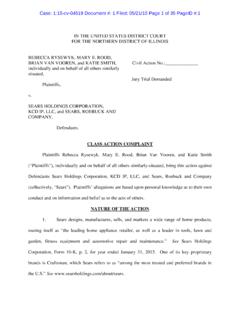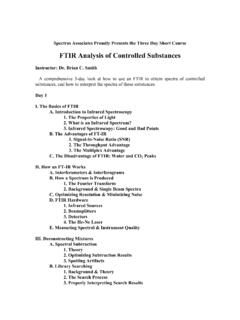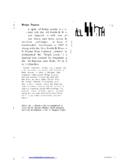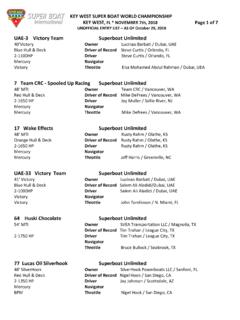Transcription of 08 Calculation models for Ultimate Limit States (Smith)
1 1 Calculation ModelsfforUltimate Limit StatesAndrew SmithCoffey Geotechnics What is new about EC7 Ultimate Limit State Design?CS? How does EC7 ULS design appear? From the point of view of a user How can we best use EC7 ULS methods?2 Contents What is new in EC7 Attributes of a new design code Some perceptions of EC7 ULS in EC7 and before Use of EC7 What has changed? Much of EC7 is little different from previous practice, :SLS calculations with partial factors unity SLS calculations with partial factors unity SI practice The main change is in ULS design: Formalises definition of ULSTil Terminology:action, effect, resistance Use of partial factors3 Attributes of a New Design Code Comprehensiveness Ease of Use Consistency Internal With previous codesWith ph sical realit With physical reality Leads to reliable and economic designSome PerceptionsFrom Bond & Harris.
2 Negativeg a cross between the European Scream and the reaction of the ostrich Codification for codification s sake Too high a cost Positive Opinions improved once people had had experience of EC74 Some Identified Problems Is passive pressure a resistance or a favourable action? (Bond & Harris) What strength should one use at ULS? Peak? Critical State? (Tony O Brien, John Atkinson) Should water pressures be factored? (Brian Simpson) The single source principle what does it mean? (CIRIA)gpp() Bond and Harris: The book deliberately presents.
3 A completely different running order from the Eurocodesso they can be explained more clearly (My italics)Example of Obscurity John Atkinson gave training sessions for Coffey He missed out the model Factor ( R:d)for Pile Design by Calculation After I drew his attention to it,it took him 20 minutes to find the reference in EC7,Even though he knew it must be there5 StaticsNewton s LawsConsistency with Physical Reality1. If a body is at rest, the sum of the forces acting on it must be zero2. (Dynamics)3. To every Action there is always opposed an equal ReactionULS Design For Limit State EQU:Edst;d Estb;d For Limit State GEOEd Rd How does the inequality affect consistency with Newton s Laws?
4 6 ULS Design For Limit State EQU:Edst;d Estb;d How does the inequality affect consistencith Ne ton s La s?consistency with Newton s Laws?ULS in Practice Pile DesignEdRd = Qs + QbQsd The resistances are not forces, they are capacities(maximum possible forces)Qb7 ULS in Practice What is the safety factor? It depends on how you define it Piping with upward water flowIt depends on how you define it Total Stresses: FS = bh2/ wh1 Effective Stresses:h2h1 FS = ( bh2- wh2 ) / ( wh1- wh2 ) For h1= 3 m, h2= 2 m FST= 40/30 = 20/10 = 2 ULS in Practice Cantilever Wall Design Problem of definition of safety factor was addressed during Problem of definition of safety factor was addressed during development of CIRIA 104 We are used to using partial factors for strength The resistances depend on the actionsand the actions depend upon the resistances8 Problems with ULS Calculations Resistances are sometimes treated as forces.
5 When in fact they are capacities resistances and actions interact This applies to any ULS Calculation , ( Global safety factors) not just EC7 (with partial factors) We are used to this with global safety factors( Hydraulic uplift, cantilever walls, slopes) Partial factors can make the problem more complex,but not intrinsically different A safety factor is still what you define it to beComparison of Global and Partial Safety Factor Methods Global safety factors are simpler, and therefore easier to get a feel forFtilbl For any particular problemand depending on how they are defined Partial factors allow better assessment of uncertainty (variation?)
6 Of real physical factors ( Variable loadings, material strengths)But how do the code factors relate to real variation? But how do the code factors relate to real variation?Have they just been chosen to fit previous codes? Thinking about partial factors has enabled better identification of inconsistencies in previous practice9 Can we Simplify ULS in EC7? Reduce to two sheets of A4: All except piles & anchors:DA1:C1A1 + M1 + R1DA1:C2A2 + M2 + R1 Piles and anchors:DA1:C1A1 + M1 + R1DA1: C2A2 + M1 or M2 + R2+ model Factor And write down what you have done!
7 Conclusions Partial Factors constitute the main new feature of EC7 ULS calculations ULS calculations have intrinsic difficulties We are used to them in global factor methods,but not yet in partial factor methods EC7 calculations can be made more straightforward10 Acknowledgements John Atkinson for Coffey training in EC7and for many useful discussions Colleagues at Coffey for sitting through two rehearsals













